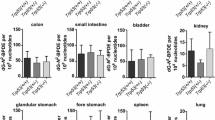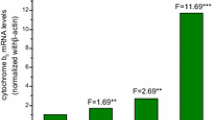Abstract
The heterocyclic amine, batracylin (BAT), is genotoxic and several lines of evidence suggest that acetylation is one step in the formation of a DNA-damaging product. The variation in susceptibility to BAT toxicity observed between rats and mice has also been linked to the acetylated product. BAT N-acetyltransferase (NAT) activity was determined in rat and mouse hepatic cytosols. Formation of acetylbatracylin (ABAT) was 6 times greater in F-344 hepatic samples compared to either mouse strain, while hepatic BAT NAT activities were similar in C57B1/6 and A/J mice. No deacetylation of ABAT was detected. In contrast, 2-aminofluorene NAT activity in C57B1/6 hepatic cytosol was twice that of the A/J strain and activities in both strains of mice were greater than in rat. Deacetylation of 2-acetylaminofluorene was detected in both species with enzyme activities in C57B1/6>A/J>F-344. Hepatocytes from the F-344 rats, the species most sensitive to BAT toxicity, were used to investigate the contribution of other biotransformation reactions to BAT cytotoxicity. Leakage of cellular lactate dehydrogenase was greater in hepatocytes from male rats than from females, increased on in vivo exposure to dexamethasone, and decreased in the presence of troleandomycin, suggesting that CYP3A-mediated biotransformation of BAT is involved in the formation of a cytotoxic product. When phenol red, a substrate for UDP-glucuronsyltransferase (UDPGT), was absent from the medium, BAT cytotoxicity was reduced. These data are consistent with a role for NAT, CYP, and UDPGT in the biotransformation of BAT.
Similar content being viewed by others
References
Ames MM, Mathiesen DA, Reid JM. Differences in N-acetylation of the experimental antitumor agent batracylin in the mouse and the rat. Invest New Drugs. 1991;9:219-25.
Boobis AR, Lynch AM, Murray S, et al. CYP1A2-catalyzed conversion of dietary heterocyclic amines to their proximate carcinogens is their major route of metabolism in humans. Cancer Res. 1994;54:89-94.
Davis CD, Schut HAJ, Adamson RH, Thorgeirsson UP, Thorgeirsson SS, Synderwine EG. Mutagenic activation of IQ, PhIP and MeIQx by hepatic microsomes from rat, monkey and man: low mutagenic activation of MeIQx in cynomolgus monkeys in vitro reflects low DNA adduct levels in vivo. Carcinogenesis. 1993;14:61-5.
El-Hawari M, Stoltz ML, Pallas F. Species di¡erences in the toxic responses to batracylin (NSC-320846). Proc Am Assoc Cancer Res. 1989;30:626.
Estrada-Rodgers L, Levy GN, Weber WW. Substrate selectivity of mouse N-acetyltransferase 1, 2 and 3 expressed in COS-1 cells. Drug Metab Dispos. 1998;26:502-5.
Flammang TJ, Kadlubar FF. Acetyl coenzyme A-dependent metabolic activation of N-hydroxy-3,2'-dimethyl-4-amino-biphenyl and several carcinogenic N-hydroxy arylamines in relation to tissues and species differences, other acyl donors, and arylhydroxamic acid-dependent acetyltransferases. Carcinogenesis. 1986;7:919-26.
Glowinski IB, Weber WW, Fysh JM, Vaught JB, King CM. Evidence that arylhydroxamic acid N,O-acyltransferase and the genetically polymorphic N-acetyltransferase are properties of the same enzyme in rabbit liver. J Biol Chem. 1980;255:7883-90.
Glowinski IB, Weber WW. Genetic regulation of aromatic amine N-acetylation in inbred mice. J Biol Chem. 1982a; 257:1424-30.
Glowinski IB, Weber WW. Biochemical characterization of genetically variant aromatic amine N-acetyltransferase in A/J and C57B1/J mice. J Biol Chem. 1982b;257:1431-7.
Guengerich FP. Microsomal enzymes involved in toxicology-analysis and separation. In: Hayes AW, ed. Principles and methods of toxicology. NewYork: Raven Press; 1982:603-4.
Halpert JA, Guengerich FP, Bend JR, Correia MA. Selective inhibitors of cytochromes P450. Toxicol Appl Pharmacol. 1994;125:163-75.
Hammons GJ, Milton D, Stepps K, Guengerich FP, Tukey RH, Kadlubar FF. Metabolism of carcinogenic heterocyclic and aromatic amines by recombinant human cytochrome P450 enzymes. Carcinogenesis. 1997;18:851-4.
Hatch FT, Knize MG, Healy SK, Slezak T, Felton JS. Cooked-food mutagen reference list and index. Environ Mol Mutagen. 1998;12(supplement 14):1-85.
Hein DW, Doll MA, Rustan TD, Gray K, Ferguson RJ, Feng Y. Construction of Syrian hamster lines congenic at the polymorphic acetyltransferase locus (NAT2): acetylator genotype-dependent N-and O-acetylation of arylamine carcinogens. Toxicol Appl Pharmacol. 1994;124:16-24.
Hultin TA, Weber WW. Genetic variability in deacetylation of 2-acetylaminofluorene and N-hydroxy-2-acetylaminofluorene in inbred strains of mice. Carcinogenesis. 1987;8:1939-41.
International Agency for Research on Cancer. Monographs on the evaluation of carcinogenic risks to humans. 1993;56:165-244.
Jarvinen M, Santti RS, Hopsu-Havu VK. Partial purification and characterization of two enzymes from guinea pig liver microsomes that hydrolyze carcinogenic amides 2-acetyl-aminofluorene and N-hydroxy-2-acetylamine fluorine. Biochem Pharmacol. 1971;20:2971-82.
Kaderlik KR, Mulder GJ, Turesky RJ, et al. Glucuronidation of N-hydroxy heterocyclic amines by human and rat liver microsomes. Carcinogenesis. 1994;1695-701.
Kato R, Metabolic activation of mutagenic heterocyclic aromatic amines from protein pyrolysates. CRC Crit Rev Toxicol. 1986;16:307-48.
Kato R, Yamazoe Y. Metabolic activation of N-hydroxylated metabolites of carcinogenic and mutagenic arylamines and arylamides by esterification. Drug Metab. 1994;26:413-30.
Lang NP, Butler MA, Massengill J, et al. Rapid metabolic phenotypes for acetyltransferase and cytochrome P4501A2 and putative exposure to food-borne heterocyclic amines increase the risk for colorectal cancer or polyps. Cancer Epidemiol Biomarkers Prev. 1994;3:675-82.
Lin DX, Lang NP, Kadlubar F. Species differences in the biotransformation of the food-borne carcinogen 2-amino-1-methyl-6-phenylimidazole[4,5,-b]pyridine by hepatic microsomes and cytosols from humans, rats, and mice. Drug Metab Dispos. 1995;23:518-24.
Lower GM, Bryan GT. Enzymatic N-acetylation of carcinogenic aromatic amines by liver cytosols of species displaying di¡erent organ susceptibilities. Biochem Pharmacol. 1973; 22:1581-8.
Malfatti MA, Buonarati MH, Turteltaub KW, Shen NH, Felton JS. The role of sulfation and/or acetylation in the metabolism of the cooked-food mutagen 2-amino-1-methyl-6-phenylimidazo[4,5-b]pyridine in Salmonella typhimurium and isolated rat hepatocytes. Chem Res Toxicol. 1994;7:139-47.
Mattano SS, Weber WW. Kinetics of arylamine N-acetyltransferase in tissues from rapid and slow acetylator mice. Carcinogenesis. 1987;8:133-7.
Mattano SS, Land S, King CM, Weber WW. Purification and biochemical characterization of hepatic arylamine N-acetyltransferase from rapid and slow acetylator mice: identity with arylhydroxamic acid N,O-acyltransferase and N-hydroxyarylamine O-acetyltransferase. Mol Pharmacol. 1989;35:599-609.
McKinnon RA, Burgess WM, Hall PM, Abdul-Aziz Z, McManus ME. Metabolism of food-derived heterocyclic amines in human and rabbit tissues by P4503A proteins in the presence of flavonoids. Cancer Res. 1992;52:2108s-13s.
McManus ME, Burgess WM, Veronese ME, Huggett A, Quattrochi LC, Tukey RH. Metabolism of 2-acetylaminofluorene and benzo(a)pyrene and activation of food-derived heterocyclic amine mutagens by human cytochromes P-450. Cancer Res. 1990;50:3367-76.
McQueen CA. Hepatocytes in monolayer culture: an in vitro model for toxicity studies. In: McQueen CA, ed. In vitro models in toxicology: model systems and methods. Cranford, NJ: Telford Press; 1989:131-55.
Meegalla SK, Stevens GJ, McQueen CA, et al. Synthesis and pharmacological evaluation of isoindolo[1,2-b]quinazolinone and isoindolo[2,1-a]benzimidazole derivatives related to the antitumor agent batracylin. J Med Chem. 1994;37:3434-9.
Meehan RR, Forester LM, Stevenson K, et al. Regulation of phenobarbital inducible cytochrome P450s in rat and mouse liver following dexamethasone administration and hypophysectomy. Biochem J. 1988;254:789-97.
Morgan ET, Thomas KB, Swanson R, Vales T, Hwang J, Wright K. Selective suppression of cytochrome P450 gene expression by interleukins 1 and 6 in rat liver. Biochim Biophys Acta. 1994;1219:475-83.
Parkinson A. Biotransformation of xenobiotics. In: Klaassen CD, ed. Casarett and Doull's Toxicology. New York: McGraw-Hill; 1996:113-86.
Plowman J, Paull KD, Atassi G, et al. Preclinical antitumor activity of batracylin (NSC 320846). Invest New Drugs. 1988;6:147-53.
Probst MR, Blum M, Fasshauer I, D'Orazio D, Meyer UA, Wild D. The role of the human acetylation polymorphism in the metabolic activation of the food carcinogen 2-amino-3-methylimidazo[4,5-f]quinoline (IQ). Carcinogenesis. 1992; 13:1713-7.
Shimada T, Gillam EMJ, Sandhu P, Guo Z, Tukey RH, Guengerich FP. Activation of procarcinogens by human cytochrome P450 enzymes expressed in Escherichia coli. Simplified bacterial systems for genotoxicity assays. Carcinogenesis. 1994;15:2523-9.
Shinohara A, Yamazoe Y, Saito K, Kamataki T, Kato R. Species differences in the N-acetylation by liver cytosol of mutagenic heterocyclic aromatic amines in protein pyrolysates. Carcinogenesis. 1984;5:683-6.
Shinohara A, Saito K, Yamazoe Y, Kamataki T, Kato R. Acetyl coenzyme A dependent activation of N-hydroxy derivatives of carcinogenic arylamines: mechanism of activation, species difference, tissue distribution and acetyl donor specificity. Cancer Res. 1986;46:4362-7.
Stanley LA, Mills IG, Sim E. Localization of polymorphic N-acetyltransferase (NAT2) in tissues of inbred mice. Pharmacogenesis. 1997;7:121-30.
Stevens GJ, McQueen CA. Species variation in the genotoxicity of batracylin. Toxicol Appl Pharmacol. 1994;126:39-44.
Stevens GJ, LaVoie EJ, McQueen CA. The role of acetylation in the mutagenicity of the antitumor agent, batracylin. Carcinogenesis. 1996;17:115-9.
Stevens GJ, Payton M, Sim E, McQueen CA. N-acetylation of the heterocyclic amine batracylin by human liver. Drug Metab Dispos. 1999;27:966-71.
Sugimura T, Nagao M. Mutagenic factors in cooked foods. CRC Crit Rev Toxicol. 1979;6:189-209.
Sugimura T, Sato S. Mutagens-carcinogens in foods. Cancer Res. 1983;43(supplement 5):2415s-21s.
Turesky RJ, Lang NP, Butler MA, Teitel CH, Kadlubar FF. Metabolic activation of carcinogenic heterocyclic aromatic amines by human liver and colon. Carcinogenesis. 1991;12: 1839-45.
Vatsis KP, Weber WW, Bell DA, et al. Nomenclature of N-acetyltransferases. Pharmacogenetics. 1995;5:1-17.
Ward A, Summers MJ, Sim E. Purification of recombinant human N-acetyltransferase type 1 (NAT1) expressed in E. coli and characterization of its potential role in folate metabolism. Biochem Pharmacol. 1995;49:1759-67.
Waud WR, Harrison SD Jr, Gilbert KS, et al. Antitumor drug cross-resistance in vivo in a cisplatin-resistant murine P388 leukemia. Cancer Chemother Pharmacol. 1991;27:456-63.
Rights and permissions
About this article
Cite this article
Stevens, G., Burkey, J. & McQueen, C. Toxicity of the heterocyclic amine batracylin: investigation of rodent N-acetyltransferase activity and potential contribution of cytochrome P450 3A. Cell Biol Toxicol 16, 31–39 (2000). https://doi.org/10.1023/A:1007692503817
Issue Date:
DOI: https://doi.org/10.1023/A:1007692503817




